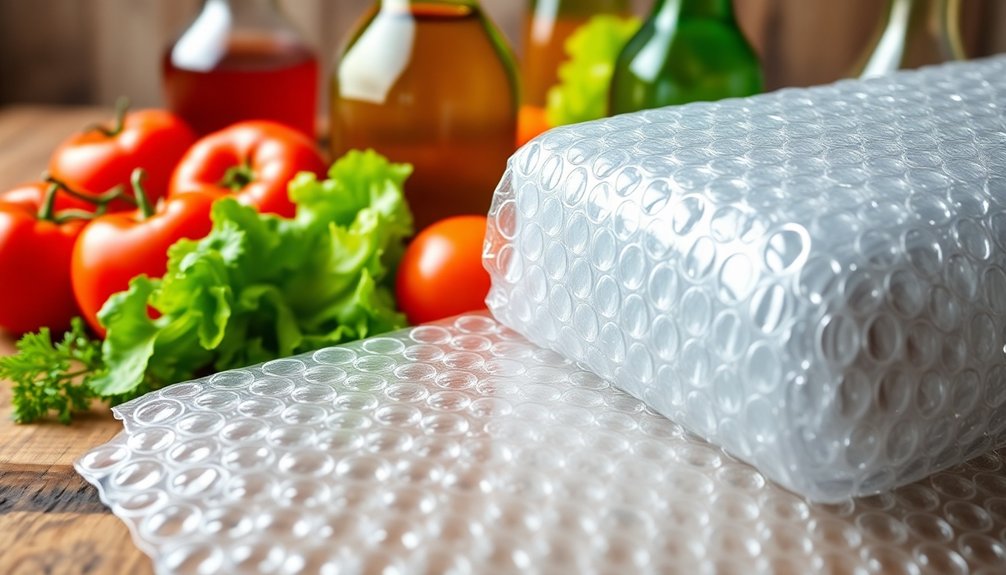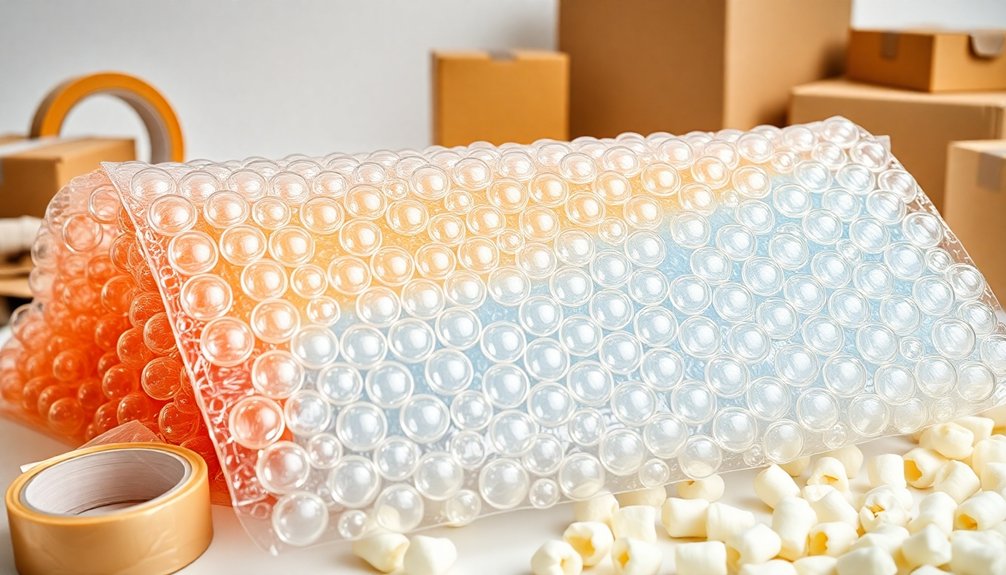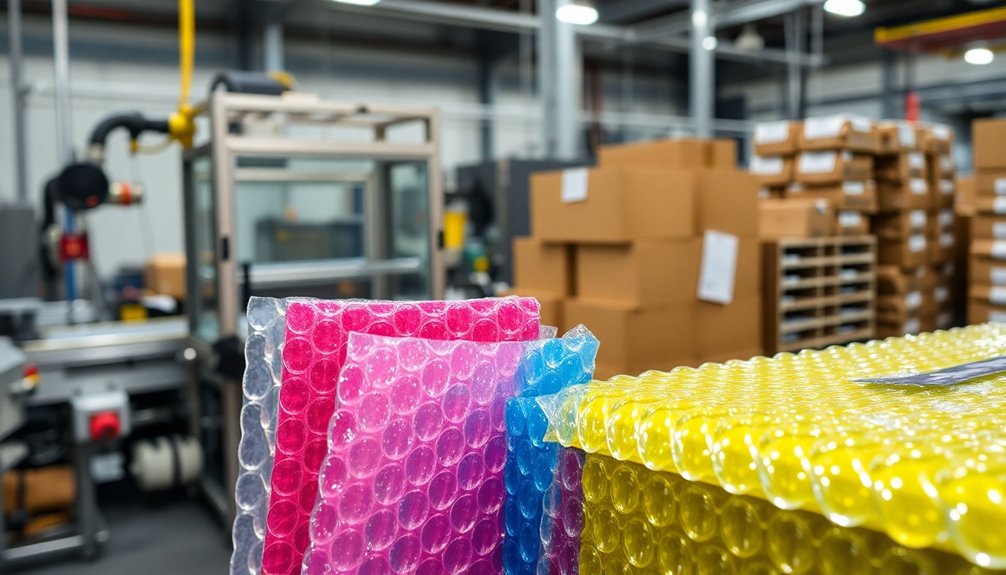Bulk bubble wrap's an invaluable asset for protecting products across various sectors, including manufacturing, healthcare, and food services. It enhances shipping efficiency by minimizing damage and reducing costs due to its lightweight nature. You've got choices, too: standard, high-grade, anti-static, or foam-backed bubble wrap, each tailored for specific needs. Plus, it's reusable, extending its lifespan and further saving you money. Whether you're shipping fragile electronics or delicate medical supplies, using the right bubble wrap makes a difference. Stay tuned to learn how to choose the best type for your needs and maximize your savings.
Key Takeaways
- Bulk bubble wrap is versatile, used in manufacturing, healthcare, food, and building services for effective product protection during shipping and storage.
- Different types include standard, high-grade, anti-static, and foam-backed bubble wrap, each catering to specific protection needs.
- Using bulk bubble wrap reduces shipping costs due to its lightweight nature and minimizes damage claims with superior cushioning.
- Reusable bubble wrap enhances cost-effectiveness, extending its lifespan and providing ongoing savings for businesses.
- Best practices include placing the bubble side inward, securing items, filling empty spaces, and using multiple layers for fragile items.
Uses Across Industries
Bubble wrap plays a crucial role across various industries, providing essential protection and insulation for a wide range of products.
In manufacturing and distribution, you'll find it crucial for safeguarding fragile electronics during transit. Its lightweight nature helps reduce shipping costs, while its versatility allows you to easily cut and mold it to fit any product shape. This minimizes product damage, saving your business from costly replacements or refunds.
In building services, bubble wrap protects delicate items like glass panels and ceramic tiles, preventing scratches and cracks during construction. It's a cost-effective solution that can be customized to fit specific infrastructure components, making it invaluable for various applications. Moreover, its thermal insulation properties help maintain stable temperatures for sensitive materials during transport.
In the food and beverage sector, you can rely on bubble wrap for efficient insulation. It creates lightweight containers that protect fragile items, like wine bottles, during long-distance shipping. Plus, the customizable design reduces material waste.
Finally, in healthcare and pharmaceuticals, bubble wrap shields sensitive medical supplies and laboratory equipment during transit. Its shock-absorbing properties provide unmatched protection, ensuring that critical items arrive safely.
These applications highlight bubble wrap's importance across multiple industries, proving its versatility and effectiveness.
Ecommerce and Retail Applications
When it comes to eCommerce, you need reliable product protection strategies to ensure your items arrive safely. Using bubble wrap not only enhances shipping efficiency but also minimizes damages, leading to fewer returns. Custom bag sizes lined with bubble material provide tailored solutions for sensitive or fragile items during shipping.
Product Protection Strategies
In an increasingly competitive eCommerce landscape, implementing effective product protection strategies is essential for safeguarding your brand and ensuring customer trust.
By taking proactive steps, you can minimize the risk of counterfeiting and enhance your product's authenticity. Here are four key strategies to consider:
- Unique Serial Numbers and Tracking: Assign serial numbers to each product to verify authenticity and assist with inventory management. This not only helps in recalls but also provides valuable data for future reference.
- Holograms and QR Codes: Use holograms that are difficult to replicate and add QR codes on packaging. Customers can scan these codes to confirm authenticity and access detailed product information.
- Distinctive Packaging: Invest in custom packaging that stands out from counterfeiters. This can help differentiate your brand and make it more recognizable to customers. Additionally, consider implementing digital protection measures such as digital watermarking to further safeguard your product designs.
- Legal Actions and IP Enforcement: Register trademarks and secure copyrights to protect your intellectual property. Regularly monitor for potential infringements and take legal action when necessary.
Shipping Efficiency Enhancements
Effective product protection strategies not only safeguard your brand but also set the stage for shipping efficiency enhancements in eCommerce and retail. To achieve this, consider integrating fast inventory management systems that offer real-time updates. This ensures your online and in-store fulfillment data is always in sync, allowing for prioritized picking logic that speeds up order processing.
Automating your inventory management minimizes manual errors and streamlines operations, while maintaining transparency across your teams. When it comes to order processing, tracking each order through every stage improves accuracy and enhances customer satisfaction. Utilizing automation tools accelerates this process, allowing local businesses to fulfill orders in under an hour, compared to larger operations that may take longer. Additionally, meeting consumer expectations for prompt and reliable deliveries is essential for building trust and loyalty among your customers.
Cost-effective shipping strategies are essential too. By optimizing inventory levels and monitoring shipping costs, you can meet customer expectations for speedy deliveries without compromising profitability.
Lastly, don't underestimate the power of protective packaging solutions like bubble wrap. Its versatility and protective qualities ensure that fragile items arrive safely, contributing to your overall shipping efficiency. Embrace these enhancements to elevate your eCommerce and retail operations.
Food and Beverage Protection

Food and beverage protection is essential for maintaining the quality and safety of your products during transport and storage.
Using bulk bubble wrap can ensure your items arrive in perfect condition, thanks to its unique properties. Here are some key benefits of using bubble wrap for food and beverage protection:
- Thermal Insulation: Metalized bubble wrap reflects heat to keep hot items hot and cold items chilled, helping to maintain the desired temperature and extend freshness.
- Food Safety: The white polyethylene interior acts as a barrier against contaminants and moisture, ensuring your food and beverages stay safe and fresh. Additionally, bubble wrap's effective cushioning protects against falls and impacts during transit.
- Cost Savings: Being lightweight, metalized bubble wrap reduces shipping costs. Plus, its cushioning capabilities allow for smaller packaging, leading to savings on materials and delivery.
- Versatility: Available in various sizes and customizable options, bubble wrap can conform to any shape, making it perfect for packaging long or odd-shaped items.
Healthcare and Pharmaceuticals Needs
When it comes to healthcare and pharmaceuticals, protecting medical equipment during transport is crucial. Bubble wrap's shock absorption benefits ensure that delicate instruments arrive intact, minimizing the risk of damage. You'll appreciate the secure transport solutions it provides, keeping both medications and equipment safe throughout their journey. Additionally, bubble packing plays a vital role in organizing medications, ensuring they are readily accessible and protected during transportation.
Medical Equipment Protection
Protecting medical equipment during transit is crucial for ensuring patient safety and maintaining the integrity of sensitive devices. Using the right packaging materials can make all the difference. Bubble wrap is an excellent choice due to its lightweight and flexible nature, which allows it to fill voids effectively. Proper packaging not only minimizes potential harm to patients but also ensures compliance with regulations and guidelines governing the shipping of medical devices.
Here are four best practices when using bubble wrap for medical equipment protection:
- Bubble Side In: Always place the bubble side against the item to maximize cushioning.
- Secure Wrapping: Completely cover the equipment with bubble wrap and secure it with tape to prevent unwrapping during transit.
- Fill Empty Spaces: Use crumpled bubble wrap or bags to fill any empty spaces in the box, keeping the item stable.
- Multiple Layers: Consider adding multiple layers of bubble wrap for extra protection, especially for fragile devices.
Following these guidelines helps ensure that your medical equipment arrives safely and functions properly.
Shock Absorption Benefits
Bubble wrap offers significant shock absorption benefits that are vital for the healthcare and pharmaceutical sectors. Its insulation properties help maintain the integrity of temperature-sensitive medications, ensuring they arrive at their destination potent and effective. By controlling temperature during transit, bubble wrap minimizes the risk of degradation for critical items like vaccines and insulin.
Additionally, bubble wrap protects medications from environmental factors. Each dose is sealed in compartments that guard against moisture, light, and air, preserving their efficacy and safety. This level of protection reduces the likelihood of medication errors, ultimately enhancing patient care.
Here's a quick overview of how bubble wrap supports healthcare needs:
| Benefit | Description |
|---|---|
| Temperature Control | Maintains requisite ranges for sensitive medications. |
| Moisture Protection | Shields against moisture that can affect potency. |
| Customizable Packaging Solutions | Tailors fit for delicate items, ensuring security. |
| Light Protection | Prevents degradation from exposure to light. |
| Integration with Advanced Tech | Allows for real-time monitoring and improved management. |
With such essential benefits, bubble wrap proves indispensable for ensuring the safety and efficacy of healthcare products.
Secure Transport Solutions
In the world of healthcare and pharmaceuticals, secure transport solutions are crucial for safeguarding high-value items during transit.
To ensure the protection of your valuable cargo, consider these key components:
1. Reliable Shipping Insurance
Customize coverage that meets your specific needs while protecting against risks like theft or temperature fluctuations.
2. Seamless Integrations
Automate your shipping processes by integrating with platforms like Shopify, which enhances order management and reduces manual errors.
3. Real-Time Monitoring
Utilize tools that allow you to track the status, location, and condition of shipments, ensuring proactive management of potential risks.
4. Comprehensive Security Measures
Implement stringent security protocols, including tamper-evident packaging and temperature-controlled containers, to protect your pharmaceuticals at every stage.
Types of Bubble Wrap

When it comes to safeguarding your fragile items during shipping or storage, understanding the various types of bubble wrap can make all the difference.
First, there's standard bubble wrap, an economical choice that provides great protection for most fragile items. It's durable, reusable, and available in various sizes, making it a go-to for e-commerce and moving needs.
If you're dealing with heavier items, consider high-grade bubble wrap. This type is made from stronger plastics that resist popping, offering robust cushioning for items at risk of significant impact.
For electronics, anti-static bubble wrap is essential. It prevents static electricity from damaging your devices during transit, making it perfect for wrapping cell phones, computers, and televisions.
Finally, foam-backed bubble wrap combines a foam layer with standard bubbles, providing enhanced surface protection. It's ideal for sensitive finishes, absorbing light impact effectively.
Choosing the right type of bubble wrap ensures your items arrive safely, no matter the circumstances.
Cost Effectiveness of Bubble Wrap
While many packaging options exist, few can match the cost effectiveness of bubble wrap for protecting fragile items.
Its unique design offers multiple benefits that save you money and enhance your packaging efficiency.
Here are four key reasons why bubble wrap is a smart choice:
- Superior Cushioning: The air-filled bubbles provide excellent protection against shocks, ensuring your fragile items arrive undamaged.
- Lightweight Material: Bubble wrap is lightweight, which means lower shipping costs and easier handling compared to heavier materials.
- Reusable: You can use bubble wrap multiple times before it needs replacing, extending its lifespan and cost-effectiveness.
- Reduced Damage Claims: By effectively cushioning your products, bubble wrap minimizes damage claims, saving you from unexpected costs.
The use of plastic materials, such as those found in plastic furniture, can also contribute to cost-effectiveness and efficiency in packaging and shipping due to their durability and resistance to damage.
Industry-Specific Applications

As businesses across various sectors seek reliable packaging solutions, bubble wrap has emerged as a go-to material for its versatility and protective qualities.
In the electronics and technology fields, it cushions sensitive equipment like smartphones and laptops, ensuring they arrive safely. Automated bubble wrap machines enhance production efficiency, delivering consistent quality tailored to specific electronic needs.
In the automotive industry, bubble wrap protects critical parts, including electronic modules and sensors, while reducing damage during shipping. Custom solutions cater to various components, streamlining the supply chain for manufacturers.
The pharmaceutical and medical device sectors also depend on bubble wrap. It safeguards fragile items such as medicines and diagnostic tools, meeting high packaging standards and regulatory requirements. Customized solutions help maintain the integrity of sensitive products during transit.
Lastly, in furniture and home goods, bubble wrap protects items like mirrors and glass tables. The automation of bubble wrap production ensures efficiency and consistent quality, making it an essential material for shipping and storage.
In every industry, bubble wrap proves its worth as a reliable packaging solution, effectively minimizing damage and enhancing safety during transportation.
Frequently Asked Questions
How Is Bubble Wrap Manufactured?
To manufacture bubble wrap, you start with LDPE resin, extrude sheets, form bubbles in molds, trap air, and seal them. Finally, you cut or roll it into desired sizes for packaging.
Can Bubble Wrap Be Recycled?
Yes, you can recycle bubble wrap! Just ensure it's clean and free of labels. Look for designated recycling bins at supermarkets or specialized collection points to properly dispose of it and support eco-friendly practices.
What Are Alternatives to Bubble Wrap?
If you're looking for alternatives to bubble wrap, consider compostable mailers, corrugated packaging, biodegradable packing peanuts, or mushroom packaging. These options provide protection while being more sustainable and environmentally friendly for your shipping needs.
How Should Bubble Wrap Be Stored?
To store bubble wrap, keep it between 55-85°F with 50% humidity. Avoid direct floor contact by using pallets, and protect it from moisture and dust in boxes to maintain its quality.
Is Bubble Wrap Effective Against Moisture?
Yes, bubble wrap's inherently water-resistant properties protect your items from moisture. It creates a barrier against humidity and spills, ensuring your sensitive belongings, like electronics and textiles, stay safe during shipping or storage.

